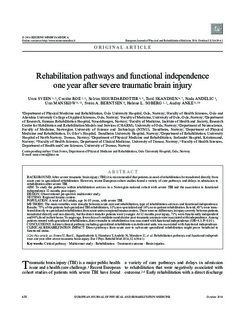| dc.contributor.author | Sveen, Unni | |
| dc.contributor.author | Røe, Cecilie | |
| dc.contributor.author | Sigurdardottir, Solrun | |
| dc.contributor.author | Skandsen, Toril | |
| dc.contributor.author | Andelic, Nada | |
| dc.contributor.author | Manskow, Unn Sollid | |
| dc.contributor.author | Berntsen, Svein A | |
| dc.contributor.author | Søberg, Helene L. | |
| dc.contributor.author | Anke, Audny | |
| dc.date.accessioned | 2017-11-16T12:56:32Z | |
| dc.date.available | 2017-11-16T12:56:32Z | |
| dc.date.created | 2016-09-01T21:17:48Z | |
| dc.date.issued | 2016 | |
| dc.identifier.citation | European Journal of Physical and Rehabilitation Medicine. 2016, 52 (5), 650-661. | nb_NO |
| dc.identifier.issn | 1973-9087 | |
| dc.identifier.uri | http://hdl.handle.net/11250/2466696 | |
| dc.description.abstract | BACKGROUND: After severe traumatic brain injury (TBI) it is recommended that patients in need of rehabilitation be transferred directly from acute care to specialized rehabilitation. However, recent European cohort studies found a variety of care pathways and delays in admission to rehabilitation after severe TBI.
AIM: To study the pathways within rehabilitation services in a Norwegian national cohort with severe TBI and the association to functional independence 12 months post-injury. DESIGN: Observational prospective multicenter study.
SETTING: Regional trauma centers.
POPULATION: A total of 163 adults, age 16-85 years, with severe TBI.
METHODS: The main variables were transfer between acute care and rehabilitation, type of rehabilitation services and functional independence. Results: 75% of the patients had specialized TBI rehabilitation, 11% non-specialized and 14% no in-patient rehabilitation. In total, 48% were trans- ferred directly to specialized rehabilitation from acute units in regional trauma centers. There were no differences in injury severity between patients transferred directly and non-directly, but the direct-transfer patients were younger. At 12 months post-injury, 71% were functionally independent and 90% lived in their home. Younger age, fewer days of ventilation and shorter post-traumatic amnesia were associated with independence. Among patients treated with specialized rehabilitation, direct transfer to rehabilitation was associated with functional independence (OR=4.3, P<0.01).
CONCLUSIONS: A direct clinical pathway including specialized rehabilitation in dedicated units was associated with functional independence.
CLINICAL REHABILITATION IMPACT: Direct pathways from acute care to sub-acute specialized rehabilitation might prove beneficial to functional status. | nb_NO |
| dc.language.iso | eng | nb_NO |
| dc.publisher | Edizioni Minerva Medica | nb_NO |
| dc.relation.uri | http://www.minervamedica.it/en/freedownload.php?cod=R33Y2016N05A0650 | |
| dc.title | Rehabilitation pathways and functional independence one year after severe traumatic brain injury | nb_NO |
| dc.type | Journal article | nb_NO |
| dc.type | Peer reviewed | nb_NO |
| dc.description.version | publishedVersion | nb_NO |
| dc.source.pagenumber | 650-661 | nb_NO |
| dc.source.volume | 52 | nb_NO |
| dc.source.journal | European Journal of Physical and Rehabilitation Medicine | nb_NO |
| dc.source.issue | 5 | nb_NO |
| dc.identifier.cristin | 1377451 | |
| dc.description.localcode | © 2016. Online version at http://www.minervamedica.it | nb_NO |
| cristin.unitcode | 194,65,30,0 | |
| cristin.unitname | Institutt for nevromedisin | |
| cristin.ispublished | true | |
| cristin.fulltext | original | |
| cristin.qualitycode | 1 | |
